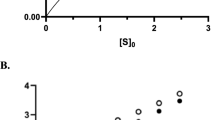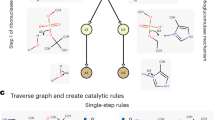Abstract
Briggs and Haldane1 showed that for the reaction sequence E + S ⇌ ES → E + P, the same form of initial rate equation is obtained by the steady-state assumption as by the more restrictive equilibrium assumption of Michaelis and Menten2. It was evident, therefore, that the Michaelis constant, Km, defined3 as the substrate concentration with which half the maximum rate is attained, is not necessarily equal to the substrate constant, Ks, the dissociation constant of the enzyme–substrate complex. Nevertheless, it is still sometimes assumed4,5 that the Michaelis constant is a measure of the affinity of the substrate for the enzyme. In a recent text-book6, it is stated that the Michaelis constant must be either equal to or greater than the substrate constant. It seems worth while to point out that this is not so, and to indicate relationships between Km and Ks values derived from reaction schemes for reversible reactions involving one and two substrates.
This is a preview of subscription content, access via your institution
Access options
Subscribe to this journal
Receive 51 print issues and online access
$199.00 per year
only $3.90 per issue
Buy this article
- Purchase on Springer Link
- Instant access to full article PDF
Prices may be subject to local taxes which are calculated during checkout
Similar content being viewed by others
References
Briggs, G. E., and Haldane, J. B. S., Biochem. J., 19, 338 (1925).
Michaelis, L., and Menten, M. L., Biochem. Z., 49, 333 (1913).
Rep. Comm. on Enzymes, I.U.B. Symp., 20, 13 (Pergamon Press, 1961).
Talalay, P., and Marcus, P. I., J. Biol. Chem., 218, 675 (1956).
Mapson, L. W., and Burton, W. G., Biochem. J., 82, 19 (1962).
Nielands, J. B., and Stumpf, P. K., Outlines of Enzyme Chemistry, 72 (John Wiley and Sons, Inc., New York, 1955).
Reiner, J. M., Behaviour of Enzyme Systems, 32 (Burgess Publishing Co., Minneapolis, 1959).
Gutfreund, H., Endeavour, 16, 217 (1957).
Dixon, M., and Webb, E. C., Enzymes, 111 (Longmans, Green and Co., London, 1958).
Theorell, H., and Chance, B., Acta Chem. Scand. 5, 1127 (1951).
Alberty, R. A., J. Amer. Chem. Soc., 75, 1928 (1953).
Dalziel, K., Acta Chem. Scand., 11, 1706 (1957).
Dalziel, K., Biochem. J., 84, 244 (1962).
Theorell, H., and McKinley-McKee, J. S., Acta Chem. Scand., 15, 1811 (1961).
Dalziel, K., Biochem. J., 83, 28, P (1962).
Dalziel, K., Biochem. J., 84, 69, P (1962).
Author information
Authors and Affiliations
Rights and permissions
About this article
Cite this article
DALZIEL, K. Physical Significance of Michaelis Constants. Nature 196, 1203–1205 (1962). https://doi.org/10.1038/1961203b0
Issue Date:
DOI: https://doi.org/10.1038/1961203b0
Comments
By submitting a comment you agree to abide by our Terms and Community Guidelines. If you find something abusive or that does not comply with our terms or guidelines please flag it as inappropriate.



